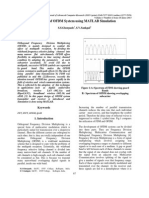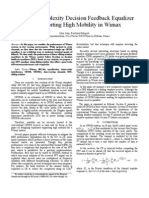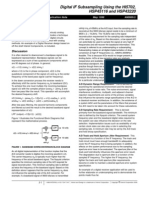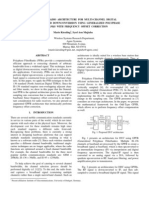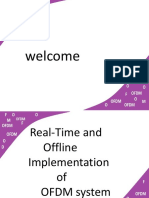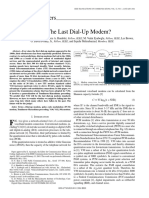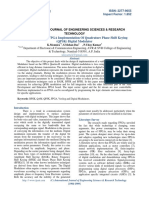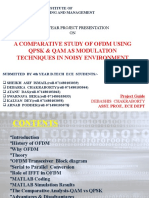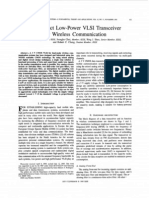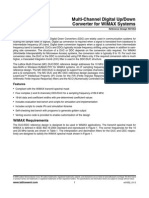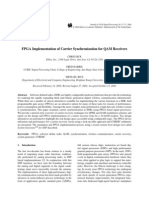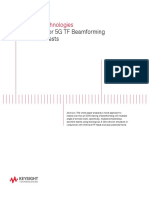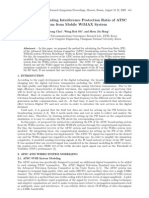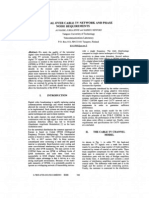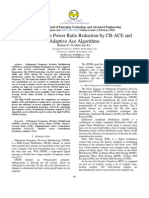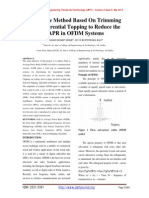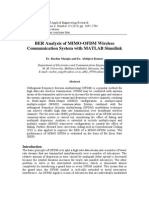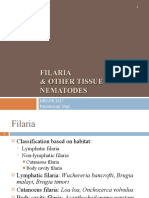Fpga Implementation of Ofdm Transceiver For A 60Ghz Wireless Mobile Radio System
Fpga Implementation of Ofdm Transceiver For A 60Ghz Wireless Mobile Radio System
Uploaded by
Boualem ZouggariCopyright:
Available Formats
Fpga Implementation of Ofdm Transceiver For A 60Ghz Wireless Mobile Radio System
Fpga Implementation of Ofdm Transceiver For A 60Ghz Wireless Mobile Radio System
Uploaded by
Boualem ZouggariOriginal Title
Copyright
Available Formats
Share this document
Did you find this document useful?
Is this content inappropriate?
Copyright:
Available Formats
Fpga Implementation of Ofdm Transceiver For A 60Ghz Wireless Mobile Radio System
Fpga Implementation of Ofdm Transceiver For A 60Ghz Wireless Mobile Radio System
Uploaded by
Boualem ZouggariCopyright:
Available Formats
2010 International Conference on Reconfigurable Computing
FPGA Implementation of OFDM Transceiver for a 60GHz Wireless Mobile Radio System
Khaled Sobaihi, Akram Hammoudeh, David Scammell Faculty of Advanced Technology University of Glamorgan, UK Email: {ksobaihi, amhammou, dscammel}@glam.ac.uk
AbstractOrthogonal Frequency Division Multiplexing (OFDM) has been adopted by most wireless and wired communication standards; these include wireless Local Area Networks (LANs) HyperLan2, 802.11a, broadband wireless (802.16) and lately the 802.15.3c for millimetre wave communications. In parallel, Field-Programmable Gate Arrays (FPGAs) have become an alternative for the implementation of those standards, due to their increased capabilities (speed and resources). This work introduces the design and performance evaluation of an OFDM transceiver, implemented on a FPGA platform for applications on a wireless millimetre wave radio system, operating around 60GHz. KeywordFPGA, HDL, Millimetre Wave, Mobile Radio, OFDM, Xilinx System Generator.
I.
INTRODUCTION
only experience the effects of flat fading. The orthogonality of the subcarriers ensures the OFDM modulation scheme is spectrum efficient. In recent years, Field-Programmable Gate Arrays (FPGAs) have become a key component for implementing high performance digital signal processing (DSP) designs particularly for digital communication systems. The logic fabric of todays FPGAs consists not only of look-up tables, registers, multiplexers, distributed and block memory, but also, dedicated circuitry for fast adders and multipliers. The memory bandwidth of modern FPGAs far exceed that of a microprocessor or a DSP processor running at clock rates two to ten times that of the FPGA. However, this DSP performance combined with the parallelism aspect of the FPGA allow the implementation of complex digital communication systems such as OFDM. II. RELATED WORKS
The interest in the unlicensed millimetre wave band, particularly the oxygen absorption zone around 60GHz, for wireless communication systems has increased dramatically. This is because of the large bandwidth available to accommodate high data-rates; and the fact that radiated power is limited to some tens of mW, lead to a good frequency reuse factor [1]. The task group TG3c under IEEE802.15.3c working group, responsible for of standardizing Wireless Personal Area Network (WPAN) systems, is now working on future WPAN systems, IEEE802.15.3c, which operates in the 60GHz millimetre-wave band. WPAN systems will support high data rate at least 1 Gbps for applications such as high speed internet access and a streaming content download (video on demand, home theatre, etc.) [2]. Orthogonal Frequency Division Multiplexing (OFDM) has been proposed for use in millimetre-wave transmission systems. This is due to OFDM having superior performance over single carrier system in multi-path wireless channels. The OFDM allows the transmission of the data over multiple orthogonal subcarriers, created by the mean of a Fourier Transform; each subcarrier is modulated independently resulting in a narrow band signal that will
978-0-7695-4314-7/10 $26.00 2010 IEEE DOI 10.1109/ReConFig.2010.40 185
There are limited publications related to the design and implementation of complete OFDM transceivers on FPGA platforms along with their performance evaluation over real wireless channels operating at millimetre waves. Work presented in [3] and [4] focused on the FPGA suitability and the resource availability to design an OFDM transceiver, without evaluating its performance under real conditions. Research published in [5] reported the implementation of an OFDM transceiver on a FPGA prototype to validate its suitability for implementation as an Application-Specific Integrated Circuit (ASIC). In contrast, work presented in [6], [7], [8] and [9] have reported the design and implementation of the transmitter part only of the OFDM system, by either using pure HDLs coding or System Generator block-set. The simulation of the OFDM system operating at millimetre waves has been emphasised in [10], [11], [12] and [13]. Those simulations demonstrated the possibility to use a high bit-rate communication system in a 60 GHz indoor wireless channel. The use of 16-QAM/OFDM for the transmission of Digital Terrestrial Broadcasting (ISDB-T) over 60GHz
channel has been reported in [14]. It has been shown that the ISDB-T signal, characterised by a low bit-rate of 6.39Mbps, was successfully transferred with a BER less than 10-6 without using forward error correction. III. OFDM TRANSCEIVER ARCHITECTURE
Simulink modelling environment using a Xilinx specific block-set. All of the downstream FPGA implementation steps including synthesis and place and route are automatically performed to generate an FPGA programming file [15].
DAC1
I Re in Re out I I
OFDM splits a data-bearing radio signal into multiple smaller signal sets and modulates each onto a different subcarrier, transmitting them simultaneously at different frequencies, by using a number of parallel subcarriers spaced orthogonally as closely as possible in frequency without overlapping or interfering [1]. Fig 1 shows the block diagram of a basic OFDM Transceiver, the input bits stream are grouped into parallel format in order to be mapped into M-QAM or M-PSK constellation (Example: 2 bits for QPSK, 4 bits for 16QAM etc...). The output of the mapping is a complex number that locates the sample on the I-Q constellation. The Inverse Fourier Transform (IFFT) block takes N samples and performs the inverse Fourier transform, the result is N-Points time domain signal that sums up N subcarriers. Those N point samples are serialised and converted to analogue format to be up-converted and sent through the channel. At the receiver, the inverse process is applied, after down-conversion the signal is converted to digital format. Those points are framed in the same order as the ones sent; in order to apply an N point Fourier transform to recover the N subcarriers. Those subcarriers are demodulated by using the corresponding de-mapping
Up-Conversion fc In bits Stream
Serial /Parallel QAM/PSK Mapping N Pts IFFT Parallel /Serial
Re
dout
Tx
-1
B Q Im in Im out Q Q
Serial to Parallel LFSR PSEUDO RANDOM GENERATOR
Im
16QAM MAPPING
Start 1
Start Done
DAC2
IFFT Tx
Tx
Out Out
Rx
Tx
Rx
Error Rate Calculation Rx
Sy stem Generator
AWGN Channel
AWGN
16QAM DEMAPPING I
Re out Re in
ADC1
I
Re
B QAM16_DEM Q
Im out
Im in
Im
Parallel to Serial Thrd 0.32501220 threshold FFT
dv Start
ADC2
Figure 2. System Generator implementation of an OFDM Transceiver
Fig 2 shows the block diagram of the OFDM transceiver to be implemented on the FPGA board by using the Xilinx block-set. This OFDM has 64 subcarriers modulated with 16-QAM scheme. The main blocks are: A. 16-QAM Mapping Each four bits generated by the pseudo random generator are mapped using the 16-QAM constellation. The In-phase and Quadrature signals are generated from the first and the last two bits respectively according to Table I. The four coding values (-3, -1, +1 and +3) are stored in a ROM memory block. The block diagram of 16-QAM mapping is demonstrated in Fig 3.
Transmitter
Channel
Down-Conversion
1 B [a:b] B2B3 addr z-1 Q ROM 2 Q [a:b] B0B1 addr z-1 I ROM 1 I
Out bits Stream
Parallel /Serial
QAM/PSK DeMapping
N Pts FFT
Serial /Parallel
Receiver Figure 1. Basic OFDM Transceiver
ADC fc
DAC
Figure 3. 16-QAM Mapping
scheme to get the correct samples, the samples are serialised back to get the bits stream initially transmitted.
TABLE I. 16-QAM Mapping Table
IV.
OFDM SIMULATION USING XILINX SYSTEM GENERATOR
B0B1 00 01 10 11
In Phase (I) -3 -1 1 3
B2B3 00 01 10 11
Quadrature (Q) -3 -1 1 3
System Generator is a DSP design tool from Xilinx that enables the use of The Mathworks model-based design environment Simulink for FPGA design. Previous experience with Xilinx FPGAs or Hardware Description Languages (HDLs) is not required when using System Generator. Designs are captured in the DSP friendly
186
B. Direct/Inverse Fast Fourier Transform The FFT and IFFT are the most important blocks in the OFDM system and their performances have a big effect on the whole system; therefore, Xilinx Intellectual Property (IP) Core is used to perform a 64 Point (number of subcarriers employed) FFT or IFFT. This IP core is well optimised for a given device and can be configured to work in pipelined streaming I/O which means that the input data and output results are continuously fetched in and out respectively; Fig 4 shows an example using this IP core block.
V.
SOFTWARE SIMULATION
The input data stream is generated from a pseudo random generator implemented by a Linear Feedback Shift Register (LFSR) block. At the receiver, and in order to recover the subcarriers, the FFT should be applied on the received samples which must have the same order as the ones transmitted. To perform this synchronisation the Done output of the IFFT block is set high upon the completion of the inverse Fourier transform. This is turn will set the Start input of the FFT block to start receiving the transmitted samples. The performance of the simulated OFDM has been evaluated over Additive White Gaussian Noise (AWGN) channel to estimate the BER for a given Signal to Noise ratio. Fig 6 compares the BER obtained from floating point simulation of the OFDM by using MATLAB Simulink and the 16-bits fixed point Xilinx block-set. The results obtained from both simulations are very similar. The floating point performs slightly better than fixed point, this is the result of the limited 16-bits word length compared to 64-bits floating point.
1.E+00
Figure 4. IFFT/FFT Xilinx IP Core
C. 16-QAM De-Mapping
1.E-01
To perform the 16-QAM demodulation of the recovered sub-carriers the Xilinx M-Code is used. The Xilinx MCode block contains MATLAB code to be executed within Simulink to calculate the block outputs during simulation. The same code is translated into equivalent behavioural HDL code when hardware is generated. The M-Code block supports a limited subset of the MATLAB language (Finite state machines and control logic). The De-Mapping is performed by assigning the received I-Q signals location to the nearest point in the I-Q constellation; therefore, I and Q signals are compared to a predefined threshold defined at the mid-way between two neighbouring points. Fig 5 illustrates this principle.
B0B1B2B3 0011 X 0010 X -3 0001 X 0000 X 0111 X +3 0110 X +1 -1 0101 X -1 0100 X -3
Bit Error Rate (BER)
1.E-02
1.E-03
1.E-04
Matlab Floating Point FPGA Fixed Point
1.E-05
-20
-15
-10
-5
10
Signal To Noise Ratio SNR (dB) Figure 6. Bit Error Rate vs SNR Ratio
Q
1011 X Threshold 1010 X +1 1001 X 1000 X 1111 X 1110 X +3 1101 X 1100 X
VI.
HARDWARE CO-SIMULATION
The implementation of the OFDM system has been performed on Xilinx XtremeDSP Developement Kit (Fig 7), the main features of this development board are:
I
a. Virtex-4 XC4VSX35 main FPGA which has a high amount of DSP blocks, b. 2 channels ADC (14-bits up to 105 MSPS), c. 2 channels DAC (14-bits up to 160 MSPS).
Figure 5. 16-QAM De-Mapping decision scheme
187
Once the simulation is verified, a hardware cosimulation block along with a hardware configuration file are generated by the System Generator. During simulation, the configuration file is loaded into the XtremeDSP developement board and the co-simulation block behaves exactly as the subsystem from which it generated, except that the simulation data is processed in hardware instead of software.
transmitter and the receiver use common oscillators in order to achieve perfect frequency synchronization. Fig 9 illustrates the received I-Q 16-QAM constellation for line of sight transmission with the transmitter and receiver 1m apart. This I-Q constellation is very clean and errors-free transmission was achieved with a bit-rate up to 200Mbps.
Figure 7. XtremeDSP development kit
Tx
I-Q Modulator
I Q
Rx
DOWN CONVERTER LNA ISOLATOR TRIPLER LNA DOUBLER I-Q Demodulator
I Q
UP CONVERTER
Figure 9. The received I-Q constellation with LOS Transmission and 1m distance VII.
CONCLUSION
POWER AMP ISOLATOR TRIPLER LNA DOUBLER SPLITTER
10.4GHz OSC
LNA
100MHz CRYSTAL SPLITTER
2.4GHz OSC
10MHz CRYSTAL
ITx FPGA Board Baseband OFDM
IRx
QTx
QRx
Control
Figure 8. OFDM baseband transceiver interfaced with 62.4 GHz radio system
Fig 8 shows the integration of the OFDM baseband transceiver with a 62.4 GHz wireless radio system. The upconversion of the baseband signal to the 64.2 GHz is done through a 2.4 GHz intermediate frequency. The inverse process is performed in the down-conversion, where the
188
The capability to design, simulate and implement an OFDM transceiver was achieved in this work by exclusively using System Generator block-set provided by Xilinx. The design targets the Xilinx FPGA Virtex4 xc4sx35-10ff668 which packs 700 kgates, 3.5 Mbits of embedded memory, 192 dedicated DSP blocks, and up to 448 I/O lines. After the mapping and routing phase, the used area is summarised in Table II. This shows there are sufficient resources to improve the OFDM transceiver by adding the coding blocks, synchronisation and carrier recovery blocks. Such blocks are mandatory to make the system work in the real world. The timing constraints reported in Table III do not show any conflict and the maximum estimated frequency is 228MHz. This is directly related to the maximum achievable bit-rate of 228Mbps. In future work and in order to ensure the correct functionality of the OFDM system, frame synchronisation would need to be implemented. In addition, the OFDM transceiver will be further improved to allow a high order modulation scheme such as 256-QAM. Equalisation techniques will also be utilised to mitigate the effect of multipath fading, particularly over the 60 GHz wireless radio channel.
TABLE II. FPGA Resources Utilisation Device Utilisation Summary Virtex4 xc4vsx35-10ff668 Used Available 3,359 30,720 2,393 15,360 4 192 44 192 TABLE III. Timing Constraints Timing summary Minimum period: 4.370ns Maximum path delay: 4.152ns Maximum frequency: 228.833MHz
Resources Slice FFs Slices RAMB16s DSP48s
Utilisation 10% 15% 2% 22%
[12] D. Sommer, G.P. Fettweis, Fast frequency correction for DQPSK-OFDM in the 60 GHz indoor environment, in IEEE International Conference on Communications, (ICC apos; 99), vol.1, 1999, pp. 157 161. [13] F. Poegel, S. Zeisberg, A. Finger, Comparison of different coding schemes for high bit rate OFDM in a 60 GHz environment, in IEEE 4th International Symposium on Spread Spectrum Techniques and Applications Proceedings, vol.1, 22-25 Sep 1996, pp. 122 125. [14] Y. Shoji, M. Nagatsuka, K. Hamaguchi, H. Ogawa, 60 GHz band 64 QAM/OFDM terrestrial digital broadcasting signal transmission by using millimeter-wave selfheterodyne system, IEEE Transactions On Broadcasting, Vol. 47, No. 3, 2001, pp. 218-227. [15] Xilinx (2009), System Generator for DSP, Getting Started Guide, [Online]. Available: http://www.xilinx.com/support/sw_manuals/sysgen_gs.pdf
REFERENCES
[1] S. J. Vaughan-Nichols, "OFDM: Back to the Wireless Future," Computer, vol. 35, no. 12, Dec. 2002, pp. 19-21 [2] IEEE 802.15 WPAN Task Group 3c (TG3c) Millimeter Wave Alternative PHY Friday, 5 February 2010, [Online]. Available: http://www.ieee802.org/15/pub/TG3c.html [3] M.J. Canet, F. Vicedo, V.Almenar, J. Valls, Fpga implementation of an if transceiver for OFDM-based WLAN, in IEEE Workshop on Signal Processing Systems, 2004. (SIPS 2004), 2004, pp.227-232 [4] F. Manavi and Y.R. Shayan, Implementation of OFDM modem for the physical layer of IEEE 802.11a standard based on Xilinx Virtex-II FPGA in 59th IEEE Vehicular Technology Conference ( VTC 2004) 2004, pp. 1768-1772. [5] S. Yoshizawa, Y. Miyanaga, H. Ochi, Y. Itho, N. Hataoka, B. Sai, N. Takayama, M. Hirata, 300-Mbps OFDM transceiver for wireless communication with an 80MHz bandwidth in Intelligent Signal Processing and Communication Systems (ISPACS 2005), 2005 pp. 213-216. [6] A. Sghaier, S. Areibi, B. Dony, A pipelined implementation of OFDM transmission on reconfigurable platforms in Canadian Conference on Electrical and Computer Engineering, (CCECE 2008), 2008, pp. 000801000804. [7] J. Garcia, R. Cumplido On the design of an FPGA-Based OFDM modulator for IEEE 802.11a, in 2nd International Conference on Electrical and Electronics Engineering, 7-9 Sept. 2005, pp. 114 117. [8] X. Jinsong, L. Xiaochun, W. Haitao, B. Yujing, Z. Decai, Z. Xiaolong, W. Chaogang, Implementation of MB-OFDM Transmitter Baseband Based on FPGA, in 4th IEEE International Conference on Circuits and Systems for Communications (ICCSC 2008), 2008, 26-28 May 2008, pp. 50-54. [9] M. Santhi, M.S. Kumar, G. Lakshminarayanan, T.N. Prabakar, Design and implementation of pipelined MBOFDM UWB transmitter backend modules on FPGA in International Conference on Computing, Communication and Networking, (ICCCn 2008), 18-20 Dec. 2008, pp. 1-6. [10] D. Sommer, G.P. Fettweis, Coherent OFDM Transmission at 60 GHz, in IEEE VTS 50th Vehicular Technology Conference (VTC 1999), Vol. 3, pp. 1545-1549. [11] D. Sommer, F. Poegel, A. Finger, G. P. Fettweis Coded OFDM at 60 GHz: System Aspects and Measurement Results, [Online]. Available: http://www.vodafonechair.com/publications/1999/Sommer_d_ofdm_99.pdf
189
You might also like
- Indoor Radio Planning: A Practical Guide for 2G, 3G and 4GFrom EverandIndoor Radio Planning: A Practical Guide for 2G, 3G and 4GRating: 5 out of 5 stars5/5 (1)
- Akan Loan Word PhonologyDocument2 pagesAkan Loan Word PhonologyAnonymous BQcnG171% (7)
- A Comparative Performance Analysis of OFDM Using MATLAB Simulation With M-PSK and M-QAM MappingDocument5 pagesA Comparative Performance Analysis of OFDM Using MATLAB Simulation With M-PSK and M-QAM MappingShilpa SharmaNo ratings yet
- OFDM Bhattacharya2017Document6 pagesOFDM Bhattacharya2017Syed Muneeb Ur RahmanNo ratings yet
- Bit Error Rate Evaluation of IEEE 802.16 in OFDM SystemDocument4 pagesBit Error Rate Evaluation of IEEE 802.16 in OFDM Systemabhi_rules08No ratings yet
- FISACDocument5 pagesFISACshravanibhor3084No ratings yet
- Peak-to-Average Power Ratio in WFMT Systems: Roman M. VitenbergDocument4 pagesPeak-to-Average Power Ratio in WFMT Systems: Roman M. VitenbergMohit AsraniNo ratings yet
- Hardware Implementation of 16qamDocument10 pagesHardware Implementation of 16qamChethanNo ratings yet
- SYSC 4607 - Lab4Document5 pagesSYSC 4607 - Lab4Aleksandra DiotteNo ratings yet
- Design of A Digital Front-End Transmitter For Ofdm-Wlan Systems Using FpgaDocument4 pagesDesign of A Digital Front-End Transmitter For Ofdm-Wlan Systems Using FpgaMd.Maruf Ahamed BeddutNo ratings yet
- Ijesat 2012 02 Si 01 02Document4 pagesIjesat 2012 02 Si 01 02Ijesat JournalNo ratings yet
- OFDM in VerilogDocument6 pagesOFDM in VerilogMarwan AhmedNo ratings yet
- BER of OFDM System Using Concatenated Forward Error Correcting Codes (FEC) Over Nakagami-M Fading ChannelDocument5 pagesBER of OFDM System Using Concatenated Forward Error Correcting Codes (FEC) Over Nakagami-M Fading Channelseventhsensegroup100% (1)
- Bapatla Women'S Engineerig College Page1Document8 pagesBapatla Women'S Engineerig College Page1David Solomon Raju YellampalliNo ratings yet
- Behaviour of OFDM System Using MATLAB SimulationDocument5 pagesBehaviour of OFDM System Using MATLAB Simulationsreekanthreddy peramNo ratings yet
- Ofdm ProjectDocument19 pagesOfdm ProjectFloraDas100% (1)
- Bandwidth Efficient Turbo Coding For High Speed Mobile Satellite CommunicationsDocument8 pagesBandwidth Efficient Turbo Coding For High Speed Mobile Satellite CommunicationsThanhha NguyenNo ratings yet
- A Novel Implementation of OFDM Using FPGA: M.A. Mohamed, A.S. Samarah, M.I. Fath AllahDocument6 pagesA Novel Implementation of OFDM Using FPGA: M.A. Mohamed, A.S. Samarah, M.I. Fath Allahtsk4b7No ratings yet
- Equalized GMSK, Equalized QPSK and OFDM, A Comparative Study For High-Speed Wireless Indoor Data CommunicationsDocument5 pagesEqualized GMSK, Equalized QPSK and OFDM, A Comparative Study For High-Speed Wireless Indoor Data CommunicationsAhmed MidoNo ratings yet
- DQPSK ModulationDocument14 pagesDQPSK Modulationkrishnak_ece7077No ratings yet
- Reduced Complexity Decision Feedback Equalizer For Supporting High Mobility in WimaxDocument5 pagesReduced Complexity Decision Feedback Equalizer For Supporting High Mobility in Wimaxjoy0302No ratings yet
- Digital IF Subsampling Using The HI5702, HSP45116 and HSP43220Document6 pagesDigital IF Subsampling Using The HI5702, HSP45116 and HSP43220Farhan BabarNo ratings yet
- An Efficient LMMSE Estimator For MIMOOFDM Systems Over Flat Fading ChannelDocument4 pagesAn Efficient LMMSE Estimator For MIMOOFDM Systems Over Flat Fading ChannelseventhsensegroupNo ratings yet
- Mario Kiessling, Syed Aon MujtabaDocument5 pagesMario Kiessling, Syed Aon MujtabaIram ArshadNo ratings yet
- OFDM Modulation Study For A Radio-over-Fiber System For Wireless LAN (IEEE 802.11a)Document5 pagesOFDM Modulation Study For A Radio-over-Fiber System For Wireless LAN (IEEE 802.11a)Muneeb Raees MalikNo ratings yet
- Researchpaper OFDM Modulator For Wireless LAN WLAN StandardDocument5 pagesResearchpaper OFDM Modulator For Wireless LAN WLAN Standardtsk4b7No ratings yet
- Error Probability of Different Modulation Schemes For OFDM Based WLAN Standard IEEE 802.11aDocument6 pagesError Probability of Different Modulation Schemes For OFDM Based WLAN Standard IEEE 802.11aaboashoorNo ratings yet
- BER Analysis and Peak To Average Power Ratio of OFDM Using QPSK and 16-QAM Digital Modulation TechniquesDocument8 pagesBER Analysis and Peak To Average Power Ratio of OFDM Using QPSK and 16-QAM Digital Modulation TechniquesRenu PareekNo ratings yet
- GFDM - Generalized Frequency Division Multiplexing: Gerhard Fettweis, Marco Krondorf and Steffen BittnerDocument4 pagesGFDM - Generalized Frequency Division Multiplexing: Gerhard Fettweis, Marco Krondorf and Steffen BittnerSaim RazaNo ratings yet
- Digital Signal FormatsDocument25 pagesDigital Signal Formatsبلال الحمودىNo ratings yet
- The LabVIEW Simulation of Space-Time Coding Technique in The MIMO-OfDM SystemDocument6 pagesThe LabVIEW Simulation of Space-Time Coding Technique in The MIMO-OfDM Systemivy_publisherNo ratings yet
- Fast Fourier TransformDocument52 pagesFast Fourier Transformاحمد ابراهيم100% (1)
- Comparison of DCT and Wavelet Based Ofdm System Working in 60 GHZ BandDocument10 pagesComparison of DCT and Wavelet Based Ofdm System Working in 60 GHZ Bandsachin10dulkarNo ratings yet
- Transactions Papers V.92: The Last Dial-Up Modem?Document8 pagesTransactions Papers V.92: The Last Dial-Up Modem?7EOoNo ratings yet
- Serial To Parallel ConversionDocument3 pagesSerial To Parallel ConversionVij AyNo ratings yet
- Ijesrt: A Verilog Design in FPGA Implementation of Quadrature Phase Shift Keying (QPSK) Digital ModulatorDocument6 pagesIjesrt: A Verilog Design in FPGA Implementation of Quadrature Phase Shift Keying (QPSK) Digital ModulatorRahulNo ratings yet
- Ofdm ProjectDocument19 pagesOfdm ProjectSourav Pramanik0% (1)
- Ijcem 102011 09Document4 pagesIjcem 102011 09DrSakthivelNo ratings yet
- Compact Low-Power Transceiver For Wireless Communication: Bang, andDocument13 pagesCompact Low-Power Transceiver For Wireless Communication: Bang, andmharitmsNo ratings yet
- Chi SNSNDocument4 pagesChi SNSNYOGESH GOWDA VNo ratings yet
- Multi-Channel Digital Up/Down Converter For Wimax Systems: FeaturesDocument13 pagesMulti-Channel Digital Up/Down Converter For Wimax Systems: FeaturesAmandeep GroverNo ratings yet
- Implementation of OFDM Transmitter and Receiver Using FPGA: Nasreen Mev, Brig. R.M. KhaireDocument4 pagesImplementation of OFDM Transmitter and Receiver Using FPGA: Nasreen Mev, Brig. R.M. Khaireankita6298No ratings yet
- FPGA Imlementation of Carrier Synchronization For QAMDocument15 pagesFPGA Imlementation of Carrier Synchronization For QAMCarlos CarriNo ratings yet
- OTA Setup For 5G TF Beamforming Functional TestsDocument8 pagesOTA Setup For 5G TF Beamforming Functional Testsmonel_24671No ratings yet
- 3ap 0619Document5 pages3ap 0619Miks MaksNo ratings yet
- DVB-T Signal Over Cable TV Network and Phase Noise RequirementsDocument4 pagesDVB-T Signal Over Cable TV Network and Phase Noise RequirementsJose Roberto Gonzales QuitoNo ratings yet
- Practical Hybrid Beamforming Schemes in Massive MIMO 5G NR SystemsDocument8 pagesPractical Hybrid Beamforming Schemes in Massive MIMO 5G NR SystemsNuno MonteiroNo ratings yet
- Wicomm T QPSKDocument13 pagesWicomm T QPSKvithyaNo ratings yet
- Performance Analysis of Wimax 802.16e Physical Layer Using Digital Modulation Techniques and Code RatesDocument6 pagesPerformance Analysis of Wimax 802.16e Physical Layer Using Digital Modulation Techniques and Code RatesOluwaseunNo ratings yet
- Implementation of Digital QPSK Modulator by Using VHDL / MatlabDocument5 pagesImplementation of Digital QPSK Modulator by Using VHDL / Matlabblesson123No ratings yet
- Peak-To-Average Power Ratio Reduction by CB-ACE and Adaptive Ace AlgorithmsDocument8 pagesPeak-To-Average Power Ratio Reduction by CB-ACE and Adaptive Ace AlgorithmsShankar GaneshNo ratings yet
- A Humble Method Based On Trimming and Differential Topping To Reduce The PAPR in OFDM SystemsDocument6 pagesA Humble Method Based On Trimming and Differential Topping To Reduce The PAPR in OFDM SystemsseventhsensegroupNo ratings yet
- BER Analysis of MIMO-OFDMDocument10 pagesBER Analysis of MIMO-OFDMAbhijeet KumarNo ratings yet
- Study of Multiple Access Schemes in 3GPP LTE Ofdma vs. Sc-FdmaDocument4 pagesStudy of Multiple Access Schemes in 3GPP LTE Ofdma vs. Sc-FdmaAbhinav GuptaNo ratings yet
- OFDM Transceiver Design With FPGA and DEMO On DE2-70 Board: ContentDocument40 pagesOFDM Transceiver Design With FPGA and DEMO On DE2-70 Board: ContentAmar NathNo ratings yet
- CC C!C" C##: C C C C C CCJDocument12 pagesCC C!C" C##: C C C C C CCJsatyagireeshNo ratings yet
- High-Performance D/A-Converters: Application to Digital TransceiversFrom EverandHigh-Performance D/A-Converters: Application to Digital TransceiversNo ratings yet
- Software Radio: Sampling Rate Selection, Design and SynchronizationFrom EverandSoftware Radio: Sampling Rate Selection, Design and SynchronizationNo ratings yet
- Radio Frequency Identification and Sensors: From RFID to Chipless RFIDFrom EverandRadio Frequency Identification and Sensors: From RFID to Chipless RFIDNo ratings yet
- PT GOLDEN TELEN RIVER 3.5T (1)Document4 pagesPT GOLDEN TELEN RIVER 3.5T (1)eko suryahadiNo ratings yet
- Computer Education - Thoery of ComputationDocument17 pagesComputer Education - Thoery of ComputationCecille Picaso MoreNo ratings yet
- Filaria N Tissue NematodeDocument27 pagesFilaria N Tissue NematodeLanny Margaretha BarutuNo ratings yet
- Introduction To Clay MineralsDocument8 pagesIntroduction To Clay MineralsBijayan Pudasaini100% (1)
- DJ Controller: Operating InstructionsDocument32 pagesDJ Controller: Operating InstructionsAlin CristianNo ratings yet
- Geography Scheme Form 2Document19 pagesGeography Scheme Form 2hillarynmakoriNo ratings yet
- Conduit Installation Manhours Per Linear MeterDocument4 pagesConduit Installation Manhours Per Linear MeterAbdullahHusainNo ratings yet
- Review On IntegrationDocument34 pagesReview On IntegrationN.J. DHARRINo ratings yet
- Unit 3 ReviewDocument3 pagesUnit 3 ReviewRodrigoNo ratings yet
- MBR TechnologyDocument114 pagesMBR Technologysebascian100% (2)
- John Milton Poehlman, David Sleper Breeding Fiel (B Ok - Org) - 169-249Document81 pagesJohn Milton Poehlman, David Sleper Breeding Fiel (B Ok - Org) - 169-249Akmal Aprian TNo ratings yet
- MSDS EcoplusDocument3 pagesMSDS EcoplusRicky Wira YudaNo ratings yet
- Bernstein Calculus For MathematiciansDocument12 pagesBernstein Calculus For Mathematicianscamiloa91No ratings yet
- Defendant Rana's Objections To The Presentence Investigation ReportDocument48 pagesDefendant Rana's Objections To The Presentence Investigation ReportThe Globe and MailNo ratings yet
- Assignment3 1Document2 pagesAssignment3 1klaus2254No ratings yet
- SUTURESDocument27 pagesSUTURESsncmanguiat.2202276.chasnNo ratings yet
- Omron Tl-YsDocument6 pagesOmron Tl-Ysedi susantoNo ratings yet
- Caring ModelDocument26 pagesCaring ModelSusheewa W. MulmuangNo ratings yet
- About Abhinavagupta: Five Short BiographiesDocument10 pagesAbout Abhinavagupta: Five Short BiographiesRajinder MahindrooNo ratings yet
- Literature Study On Bus TreminalDocument3 pagesLiterature Study On Bus TreminalVenkat100% (3)
- Y10 05 P30 Assessment v2Document7 pagesY10 05 P30 Assessment v2ayten.sherifNo ratings yet
- 1.1-Half Wave Rectifier (Uncontrolled)Document26 pages1.1-Half Wave Rectifier (Uncontrolled)Mohamedein MaghrabyNo ratings yet
- Exercise 01Document2 pagesExercise 01Phuong DoanNo ratings yet
- Generic Structure of Descriptive TextDocument2 pagesGeneric Structure of Descriptive TextJolly Roger GianyarNo ratings yet
- CH Student List 2017 18Document8 pagesCH Student List 2017 18Pushpendra VermaNo ratings yet
- Laws of Human NatureDocument53 pagesLaws of Human NatureSaleha Tariq67% (6)
- DEll PMSDocument64 pagesDEll PMSDipak ThakurNo ratings yet
- Technical Guidance LPC Rules Eng 20200911 153808Document58 pagesTechnical Guidance LPC Rules Eng 20200911 153808catalin.pop24No ratings yet
- GB Construction Training Philippines Inc. Actual Work Acticity - Grading SkillsDocument3 pagesGB Construction Training Philippines Inc. Actual Work Acticity - Grading SkillsYeng LugtuNo ratings yet














